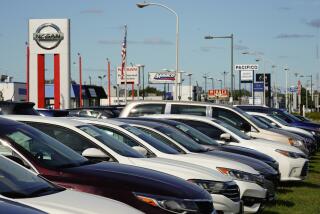Longer loans can be shortsighted
- Share via
Nearly four of 10 consumers who traded in for a new car last year owed more on their trade-in than it was worth, says industry researcher J.D. Power and Associates.
The auto industry calls this “negative equity” or being “upside down.” And the number is up from 25% in 2001.
Half the buyers younger than 40, and 56% of Gen Y, are upside down, Power says.
Gen Y, the oldest of whom are 28, also tends to have the longest car loans -- 65 months versus the industry average of 62.
“You’re seeing a lot of pressure [from young buyers] to keep the monthly payment down by extending it out,” said Tom Libby, chief analyst of the Power Information Network, the research firm’s statistics-gathering unit. He added that this could leave them owing more than what the car is worth, the basic definition of being upside down, for a long time.
Stretching out the loan makes monthly payments more affordable, but CNW Marketing Research says it also means buyers have to wait longer to have equity in their car.
Many variables go into determining whether a car buyer is upside down -- down payment, loan term and resale value among them. But Art Spinella, CNW president, has some basic rules of thumb:
* Even with a down payment of 15% of the purchase price, a typical buyer who takes a 60-month loan is upside down for 45 months, because the vehicle’s value drops faster than the loan principal.
* On an 84-month loan, the average buyer is upside down for 73 months. Some banks give 96-month loans, and Spinella says the negative equity lasts nearly seven years.
Banks and finance companies used to require a 15% to 20% down payment or trade-in value. Spinella says some now will lend more than the sticker price, allowing consumers to roll current debt into a new loan.
CNW estimates that 25% of all new-vehicle buyers who took out loans last year were upside down when they drove out of the showroom, with the average amount they rolled into a new loan at $3,000.
“It’s not a huge amount, but you’re adding $3,000 to the [average] $25,000 price of the car,” Spinella said, adding that the buyer is still paying for a car he or she no longer own.
Consumers who owe on their trade-in often rely on cash rebates to cover some of the old debt, Spinella said, because “a low interest rate doesn’t help get the deal done, and a rebate will.” In addition, an upside-down buyer may not qualify for special financing, leaving the rebate as the only option.
Though rebates help upside-down owners buy new cars, they also keep them in hock longer because rebates reduce a vehicle’s resale value.
Scion, Toyota’s fledgling brand aimed at Gen Y, says upside down hasn’t been an issue, though the brand has been in business less than two years. Most loans for Scions are for four or five years.
“The question is what they’re going to do in the middle of the [loan] term,” said Jim Farley, recently named vice president of marketing for Toyota after heading Scion since its inception. “Upside-down is a huge issue for the industry,” he added, because it can keep would-be buyers out of the market longer.
Scion, it should be noted, has not offered a rebate.
“The kids are figuring it out for themselves,” he said. “They’re getting a loan from their grandparents or their credit union before they come into the dealer.”
Twenty-five percent of Scion buyers pay cash for their cars, meaning they obtained the money from a lending institution, relatives or personal savings.
About 30% of Scion sales financed through Toyota dealers require a co-signer -- the young buyers are using their parents’ credit history to get a loan.
More to Read
Inside the business of entertainment
The Wide Shot brings you news, analysis and insights on everything from streaming wars to production — and what it all means for the future.
You may occasionally receive promotional content from the Los Angeles Times.










